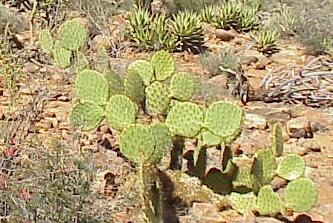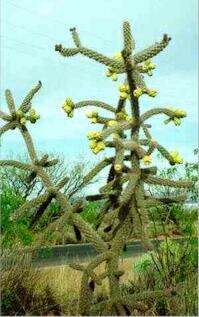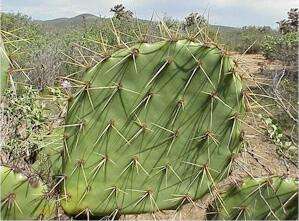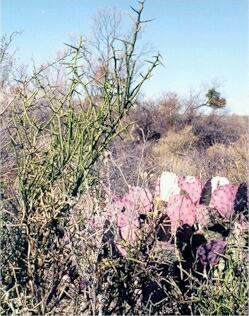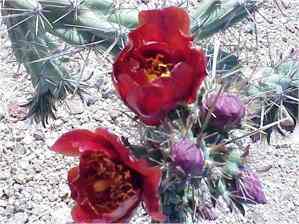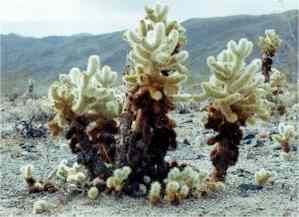PRICKLY PEAR AND CHOLLA CACTI (Opuntia
species) The genus Opuntia covers two main groups of cacti - the prickly pears, which have large, flattened pads that stand erect and are jointed together, and the chollas, which have more cylindrical segments and usually have a tree-like growth form. This distinction is clearly seen in the two images below.
Despite this difference in growth form, all Opuntia species have three features in common.
The many species of Opuntia are found from southern Canada down to southern South America, growing in a wide range of habitats. They also have been introduced, and thrive, in many other countries. Indeed, the prickly pear has become a major pest in some Australian rangelands. In the desert regions of southwestern USA and Mexico chollas tend to be found in the warmer, drier areas, whereas prickly pears usually are found in wetter areas. Most species of Opuntia produce conspicuous flowers, which are pollinated by a specialist group of bees - the cactus bees which collect pollen from the flowers to feed their larvae. The resulting fruits are eaten by many animals (and by humans), leading to seed dispersal. However, many species of Opuntia perhaps rely just as much on vegetative propagation, when joints break off the parent plant and take root after rains. In desert conditions this can be a more reliable means of propagation than regeneration from seeds, because many seedlings never survive to reach maturity. In several cholla species, in particular, the joints can break off easily when an animal (or human) brushes against them and carries the joint to a new location. The teddy bear cholla is a classic example of this - its fruits are sterile so it probably relies almost entirely on vegetative spread. Prickly pears There are many different species of prickly pear in the desert regions of North America, but they are difficult to tell apart because they tend to hybridise where their ranges overlap. They differ in colour of the pads (ranging from greyish-green to purple), the number and size of the spines, the branching habit, and flower colour. Three examples of this variation are shown below.
In Mexico about 100 different species have been recognised. The prickly pears also are cultivated widely as a food source in Mexico, because the young pads can be cooked and eaten as a vegetable, while the fruits can be made into jams and syrups. The plants used for this purpose were specially selected and modified by early Spanish colonists, having few or no spines. They now grow commonly as "escapes" along roadsides. Prickly pears are a major food source for the javelina (collared peccary) - a wild, pig-like animal that frequents the deserts of southwestern USA and Mexico. These animals are common only where prickly pears are abundant. Chollas Several cholla species are sufficiently distinct to be identified easily, although some of them can hybridise, and the frequency of vegetative propagation can lead to clones (genetically identical individuals, derived from a single parent) which show minor differences from place to place. Some of the more distinctive and ecologically important species are covered on a separate page (see Chollas). Chollas also are important in supporting animal populations. In particular, they provide the main nesting sites for cactus wrens, and cholla joints are used frequently by the white-throated woodrat, to protect its nests from intrusion by predators.
|
